
IN THE HIGH COURT OF SOUTH AFRICA
FREE STATE DIVISION, BLOEMFONTEIN
|
Reportable: Of Interest to other Judges: Circulate to Magistrates: |
YES NO NO |
Case no 1723/2023
In the matter between:
AKZONOBEL COATINGS INTERNATIONAL B.V 1st Applicant
AKZONOBEL SOUTH AFRICA (PTY) LTD 2nd Applicant
and
DUMAX PAINTS (PTY) LTD 1st Respondent
BOINKO TRADING & INVESTMENTS (PTY) LTD 2nd Respondent
THE COMMISSIONER OF THE COMPANIES &
INTELLECTUAL PROPERTY COMMISSION 3rd Respondent
CORAM: JP DAFFUE J
HEARD ON: 19 OCTOBER 2023
DELIVERED ON: 09 NOVEMBER 2023
ORDER
1. The first and second respondents are interdicted and restrained in terms of s 34(1)(c) of the Trade Marks Act 194 of 1993 from infringing the second applicant’s well-known trade mark registration number 1931/00131 Dulux in class 2 by using in the course of trade in relation to any goods or any services, any name, trade mark, trading style, company or domain name identical or similar to the second applicant’s well-known registered Dulux trade mark, including but not limited to the name and trading style DUMAX and/or DUMAX PAINTS and/or any other similar trade mark to the second applicant’s aforementioned well-known registered Dulux trade mark.
2. The first and second respondents, are ordered to pay, jointly and severally, the one to pay the other to be absolved, the applicants’ costs, including the costs consequent upon the employment of senior counsel.
JUDGMENT
INTRODUCTION
[1] Two rival traders in the paint industry are at loggerheads. The one trader is a renowned trader whose registered trade mark, Dulux, has been established internationally and nationally over many decades. The other trader is a new entrant into the market, having been established in the beginning of 2021. It started to use the trade name, DUMAX, thereafter. Two main issues are to be considered. First, the get-up of the two rival traders. Second, the respondents’ entitlement to use the name DUMAX, either on its own, or as part of the name DUMAX PAINTS.
[2] The application papers are in excess of 800 pages. The founding, answering and replying affidavits consist of just over 100 pages, whilst the remainder of the documents are made up of numerous annexures, including websites, photographs and numerous other items.
THE PARTIES
[3] The first applicant is Akzonobel Coatings International B.V., a Dutch company and wholly owned subsidiary of Akzonobel N.V., a Dutch multinational company which creates and manufactures paints and performance coatings for both industry and consumers worldwide with its headquarters in Amsterdam. The second applicant is Akzonobel South Africa (Pty) Ltd, a South African company. Akzonobel N.V. owns 100% of the issued share capital of both applicants. The second applicant is engaged in the manufacturing, marketing and distribution in South Africa of paints, varnishes and related products and services primarily under the Dulux trade name. Adv R Michau SC appeared for the applicants, instructed by Spoor and Fisher, c/o Phatshoane Henney Attorneys, Bloemfontein.
[4] The first respondent is DUMAX PAINTS (Pty) Ltd, a South African company with its registered address in Bloemfontein, which trades under the name DUMAX PAINTS. It manufactures, sells and distributes paints and varnishes in South Africa under the trade name DUMAX. The second respondent is Boinko Trading & Investments (Pty) Ltd with registered address at Kathu, Northern Cape. This company also claims rights to the DUMAX trade mark in South Africa. The sole director of both companies is Mr Kagiso Isaac Nkono. Adv P Mthombeni appeared on behalf of the respondents, instructed by Motlhamme Attorneys, Bloemfontein.
[5] The third respondent is the Commissioner of the Companies and Intellectual Property Commission who played no role in the proceedings.
THE RELIEF SOUGHT
[6] The applicants sought a final interdict in terms of s 34(1)(a) of the Trade Marks Act 194 of 1993 (the TMA), restraining the first and second respondents from infringing the first and second applicants’ registered trademarks as more fully set out in prayers 1 to 3 of the notice of motion as well as second respondent’s trade mark registration in terms of s 34(1)(b) as contained in prayer 4.
[7] Second, a final interdict was sought in terms of s 34(1)(a) in the case of the trade mark registration number 2016/01648 MAXICOVER.
[8] Third, a final interdict was sought in prayer 5 in terms of s 34(1)(c) against the respondents, restraining them from infringing the second applicant’s aforesaid trade mark registration number 1931/00131 Dulux by using in the course of trade in relation to any goods or any services, any name, trade mark, trading style, company name or domain name identical or similar to the Dulux trade mark, including but not limited to the name and trading style DUMAX and/or DUMAX PAINTS and/or any other similar trade mark to the second applicant’s aforesaid well-known registered Dulux trade mark.
[9] Fourth, a final interdict was sought against the two respondents, restraining them from passing-off their goods and/or services as that of the applicants.
[10] Fifth, an order was sought in terms of s 11(2)(a)(iii) read with s 160(3)(b)(ii) of the Companies Act 71 of 2008, ordering the first respondent to change its company name, failing which the third respondent be ordered to act accordingly as set out in prayers 8 and 9.
[11] Finally, and except for a prayer for costs, including the costs of two counsel, the applicants sought an order in prayer 10 against the first respondent pertaining to the payment of royalties as contemplated in s 34(3)(d), after complying with directions to be issued regarding the requisite enquiry.
THE COMMON CAUSE FACTS
[12] The applicants are the owners of several trade marks and trade mark registrations with the name Dulux on its own or with other words such as ‘Specialist Paint Centre’, ‘Cover-all’ and ‘MaxiCover’. In summary, the applicants are in the paint industry, specialising in the manufacturing and selling of paint products and advisory services in that regard.
[13] The success of the Dulux brand internationally and in this country and its enormous reputation and goodwill as a well-known trade mark is beyond doubt.
[14] The first respondent as a company was incorporated in January 2021 where after it started selling paint products under the trade name DUMAX and/or DUMAX Paints.
[15] The first respondent copied an identical image from the first applicant’s website onto its website in order to promote its products. After demand, it removed the image and this issue does not need any further attention, save insofar as it has a bearing on the respondents’ deponent’s bona fides.
[16] The applicants’ slogan as used on its products is ‘[T]he future of paint today’, whilst the respondent’s slogan is ‘[P]ainting the future’.
[17] Although the first respondent is using the trade mark, DUMAX, the second respondent has filed a trade mark application in respect of DUMAX.
[18] In terms of the second respondent’s application for a trade mark, the respondents now use the sign TM. The applicants filed a caveat against the trade mark application and intend to oppose the application, once advertised in terms of the TMA.1
[19] T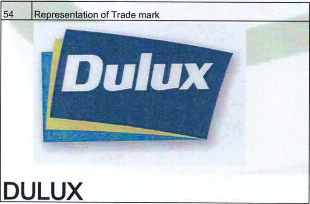

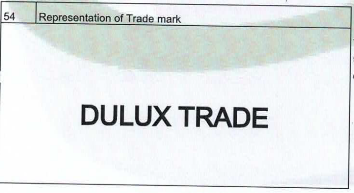 he following are the applicants’ various trademarks with the second respondent’s mark, conditionally approved by the Registrar of Trade Marks, thereunder:
he following are the applicants’ various trademarks with the second respondent’s mark, conditionally approved by the Registrar of Trade Marks, thereunder:
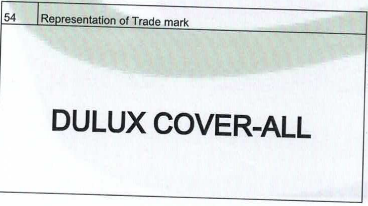
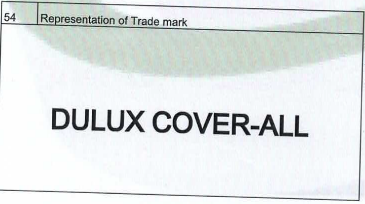
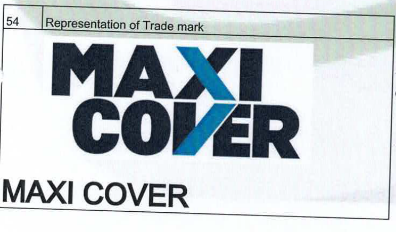
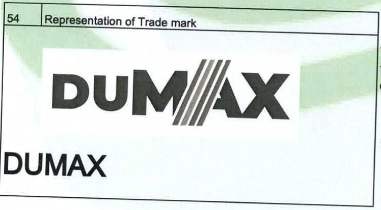
[20] O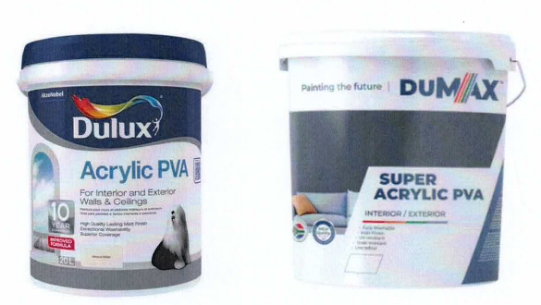
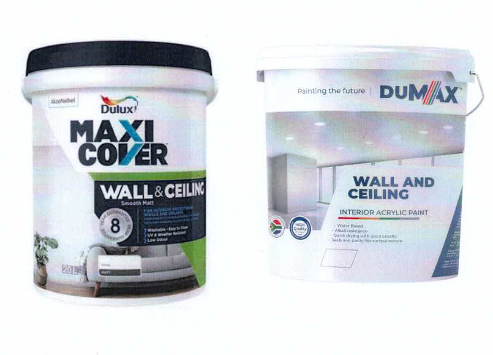 n the applicants’ get-up one finds a flourish device on top of the word Dulux, whilst the first respondent is using a rainbow-like device in conjunction with the DUMAX trade mark. The last-mentioned device is running down diagonally between the ‘M’ and the ‘A’ and forms part of the left leg of the ‘A’. In both instances the parties make use of red, orange, yellow, green and blue colours. The following are some of the get-ups used by the parties:
n the applicants’ get-up one finds a flourish device on top of the word Dulux, whilst the first respondent is using a rainbow-like device in conjunction with the DUMAX trade mark. The last-mentioned device is running down diagonally between the ‘M’ and the ‘A’ and forms part of the left leg of the ‘A’. In both instances the parties make use of red, orange, yellow, green and blue colours. The following are some of the get-ups used by the parties:
ISSUES IN DISPUTE
[21] Respondents denied that the applicants had proven the requisites to obtain a final interdict and in particular denied that they had proven a clear right.
[22] The respondents denied that the applicants are entitled to any relief, either based on passing-off, or infringement of the Dulux trade marks.
[23] The respondents submitted that the application is premature. They relied on the conditional approval of the second respondent’s trade mark by the Registrar of Trade Marks and the pending procedure in which the applicants may cooperate if they wish to oppose that application.
STATUTORY PROVISIONS PERTAINING TO INFRINGEMENT OF A REGISTERED TRADE MARK
[24] Section 34 of the TMA is the relevant section. It reads as follows:
‘34 Infringement of registered trade mark
(1) The rights acquired by registration of a trade mark shall be infringed by-
(a) the unauthorized use in the course of trade in relation to goods or services in respect of which the trade mark is registered, of an identical mark or of a mark so nearly resembling it as to be likely to deceive or cause confusion;
(b) the unauthorized use of a mark which is identical or similar to the trade mark registered, in the course of trade in relation to goods or services which are so similar to the goods or services in respect of which the trade mark is registered, that in such use there exists the likelihood of deception or confusion;
(c) the unauthorized use in the course of trade in relation to any goods or services of a mark which is identical or similar to a trade mark registered, if such trade mark is well known in the Republic and the use of the said mark would be likely to take unfair advantage of, or be detrimental to, the distinctive character or the repute of the registered trade mark, notwithstanding the absence of confusion or deception: Provided that the provisions of this paragraph shall not apply to a trade mark referred to in section 70 (2).
(2) ……
(3) Where a trade mark registered in terms of this Act has been infringed, any High Court having jurisdiction may grant the proprietor the following relief, namely-
(a) an interdict;
(b) ….;
(c) ….;
(d) in lieu of damages, at the option of the proprietor, a reasonable royalty which would have been payable by a licensee for the use of the trade mark concerned, including any use which took place after advertisement of the acceptance of an application for registration and which, if taking place after registration, would amount to infringement of the rights acquired by registration.
(4) For the purposes of determining the amount of any damages or reasonable royalty to be awarded under this section, the court may direct an enquiry to be held and may prescribe such procedures for conducting such enquiry as it may deem fit.
(5) …..’ (My emphasis)
[25] It will be recalled that the applicants relied for relief on all three subsections of s 34(1), as well as the common law remedy of passing-off. I shall deal with the submissions under the next heading.
EVALUATION OF THE EVIDENCE AND THE PARTIES’ SUBMISSIONS
Change of 1st respondent’s company name
[26] The first issue to be addressed is the applicants’ reliance on s 11 of the Companies Act in seeking an order that the first respondent shall change its company name, to wit Dumax Paints (Pty) Ltd. In order to determine whether a company name satisfies the requirements of the Companies Act, one must have regard to s 11 of the Companies Act. Whilst there is an inter-relatedness between the Companies Act and the principles of trade mark law, there are distinct differences of importance. No doubt, the relevant enquiry in respect of the Companies Act is the name alone and not the entire trade mark as is the case in the TMA. Furthermore, the respective goods and/or services in respect of which the trade mark relied upon is registered, have no bearing on the question of confusion in relation to company names. In any event, this issue does not have to be considered by the court for the reason mentioned in the next paragraph.
[27] The applicants relied inter alia on the registered trade mark, Dulux, in claiming trade mark infringement, but there is no company registered with the CIPC under such name. Mr Michau correctly conceded during oral argument that this court could not grant the relief sought in terms of s 11(2)(a)(iii) read with s 160(3)(b)(ii) of the Companies Act. The correct entity to deal with the issue is the Companies Tribunal, which has to consider any confusion between company names as is evident from the various rulings of the Companies Tribunal referred to by Mr Michau in his heads of argument. The relief sought in prayers 8 and 9 of the notice of motion should be refused.
Passing-off
[28] Passing-off is a common law remedy and concerns a trader’s get-up, including its trading name. In Capital Estate and General Agencies Pty Ltd v Holiday Inns Inc and Others2 the court defined passing-off as follows:
‘The wrong known as passing off consists in a representation by one person that his business (or merchandise, as the case may be) is that of another, or that it is associated with that of another, and, in order to determine whether a representation amounts to a passing-off, one enquires whether there is a reasonable likelihood that members of the public may be confused into believing that the business of the one is, or is connected with, that of another.’
[29] It is trite that proof of passing-off requires proof of reputation, misrepresentation and damage. Reputation is not an issue in casu as the Dulux trade mark has been in substantial use for decades. The use may also be inferred from the extensive sales and marketing of Dulux products which have been conceded by the respondents.3 Whether a mark is well-known has been considered in Truworths Ltd v Primark Holdings.4 The manner and scale of the use of a trade mark can in itself be sufficient to warrant a conclusion that the relevant public regards it as distinctive of its owner.5
[30] The use of different names in otherwise similar get-ups does not necessarily exclude the probability of deception. In Blue Lion Manufacturing (Pty) Ltd v National Brands Ltd6 (Blue Lion) the competing marks were ‘Tea Lovers’ and ‘Tennis biscuits’. The Supreme Court of Appeal7 emphasised in Blue Lion that the fact that rival traders choose to imitate their competitors’ get-up and then seek to maintain their imitation suggests that they believe that the imitation confers some advantages on them that different or original get-ups would not provide. In that case the court referred to the competitor’s explanation as to why it changed the wrappings of its Tea Lovers biscuits to identify so closely with that of National Brands as a ’sheer evasion’.8 I have reason to believe that the respondents’ explanation in casu is of a similar nature. I deal with this in detail hereunder. Suffice to say at this stage that they obviously elected the name DUMAX in order to sail as close as possible to the wind. But, as is trite and confirmed in numerous judgments of our courts, ‘imitation is the lifeblood of competition’ and the ‘bare imitation of another’s product, without more, is permitted.’9
[31] In Quad Africa Energy (Pty) Ltd v Sugarless Co (Pty) Ltd and Another10 the Supreme Court of Appeal had to consider passing-off as well as trademark infringement. Pertaining to the packaging of the rival traders, the court dealt with the similarities, but found there were overwhelming dissimilarities, especially in respect of the logo’s.11 In that case the trade marks, Sugarless and Sugarlean, formed part of the get-up.
[32] The latest judgment on passing-off is Dart Industries Inc and Another v Botle Buhle Brands (Pty) Ltd and Another.12 The Supreme Court of Appeal had to deal with the similarities between hourglass shaped bottles of two competitors, Tupperware’s Eco bottles and the Botle Buhle bottles. The court emphasised that ‘the law against passing-off is not designed to grant monopolies in successful get-ups’ and that a certain measure of copying is permissible. Furthermore, in order to reach a conclusion that confusion is likely, the entire get-up of the respective products must be compared, including the shapes, the markings and the decorations on the products, as well as how the respective trade marks are applied to the products. In this case the words ‘Tupperware’ and ‘Botle Buhle’ embossed on the bottles did not assist to differentiate as they were inconspicuous. The court concluded that the requirements for passing-off were met. It accepted,13 based on a dictum in Pioneer Foods (Pty) Ltd v Bothaville Milling (Pty) Ltd14 that if there is a likelihood of confusion, or deception, there is usually a likelihood that damage will follow.
[33] In casu, the dissimilarities are obvious. I refer to the examples of the get-ups of the two rival parties as shown above. Having considered the authorities quoted above, I am not convinced that the applicants are entitled to relief based on passing-off. However, this is not the end of the matter as will become clear in the next paragraphs.
Premature application
[34] The respondents submitted that the applicants’ application is premature and should be dismissed for that reason only. They incorrectly alleged that the first respondent had applied for registration of the DUMAX mark as a trade mark which application had been accepted conditionally.15 This is not correct. The objective evidence shows that the second respondent has applied for registration of the trade mark and obtained conditional rights. The respondents also submitted that if an interdict would be granted, this court would effectively hamstring the Registrar of Trade Marks to consider the pending trade mark application. Consequently, they averred, the applicants should lodge their objections against the trade mark application, once it is advertised as provided for in s 21 of the TMA.
[35] The applicants have a totally different approach. According to them the respondents are confusing trade mark infringement proceedings with trade mark opposition proceedings. The respondents had to answer inter alia a trade mark infringement case, whilst the process before the Registrar of Trade Marks is irrelevant for purposes of the present application.16 I agree there is no reason to dismiss or stay the application.
[36] It is perhaps appropriate to mention at this stage that there is a close connection between the requirements for trade mark registration and those contained in s 34(1)(c). I quote s10(17) of the TMA:
’10. The following marks shall not be registered as trade marks or, if registered, shall, subject to the provisions of sections 3 and 70, be liable to be removed from the register:
(17) a mark which is identical or similar to a trade mark which is already registered and which is well-known in the Republic, if the use of the mark sought to be registered would be likely to take unfair advantage of, or be detrimental to, the distinctive character or the repute of the registered trade mark, notwithstanding the absence of deception or confusion, unless the proprietor of such trade mark consents to the registration of such mark:….’
[37] In National Brands (Ltd) v Cape Cookies CC and Another17 ‘Snackcrax’ was held to be too close to ‘Salticrax’ for the purpose of s 10(17) of the TMA which I quoted above. As mentioned, this subsection deals with similar considerations as in s 34(1)(c).
Trade mark infringement
[38] According to the first respondent it started to trade under the name and style of DUMAX Paints (Pty) Ltd after its registration which was in January 2021. Consequently, it has exclusive rights to trade under the aforesaid name and style. It is the first respondent’s case that it is an emerging company, recently established and entirely owned by a black person. According to the respondents’ deponent the applicants ‘brag about the historic dominance’, but it is clear that ‘this monopoly and dominance’ are what the applicants seek to protect by ‘muzzling lawful competition’ and thereby ‘essentially trying to squeeze the first respondent out of the market.18 He then continued his political argument by stating that the applicants’ conduct is ‘an antithesis of transformation and has a massive potential to halt the economic transformation’, bearing in mind ‘that during the years in which the applicants were formed, black people were not allowed to participate in the mainstream economy …’19
[39] The respondents relied in no uncertain terms on the right of previously disadvantaged persons to be allowed to become competitive in markets from which they were excluded during apartheid. I am satisfied that I may consider the TMA and the issues which have arisen herein through the prism of the Constitution. Section 22 stipulates that ‘(E)very citizen has the right to choose their trade, occupation or profession freely.’ The section continues to make it clear that such practice may be regulated by law. The respondents are new entrants in a competitive market. There is no doubt that the Dulux trade mark is dominant to such an extent that the Competition Commission recently refused to consent to the merger of Dulux and Plascon, the biggest and second biggest paint brands in South Africa, the reason being that it would limit competition.
[40] No one can claim an absolute right to exercise their trade or profession without interference and in so doing contravene the rights of their rivals. This is trite. Although the importance of a free market and robust competition cannot be under-estimated, no one shall be allowed to interfere with the clear rights of others.
[41] It is ironic that when Mr Mthombeni pronounced the words Dulux and Dumax in one particular sentence during his oral argument, his pronunciation of the two words was so remarkably the same that I commented about it at the time. In my view it is fair to say that, save for the identical first syllable, ‘Du’, the second syllable in both words may often be pronounced the same, eg as in ‘sucks’. Also, both words end on an ‘x’. It is apposite to mention that it is the applicants’ case that the word DUMAX is a combination of DU for Dulux and MAXICOVER, the last being one of the registered trademarks referred to above.
[42] In casu, the respondents’ deponent did not explain convincingly why the trade mark DUMAX was chosen, save to say that the name ‘resonates with [his] vision’.20 I referred earlier to the fact that the first respondent copied an identical image of the first applicant’s website onto its own website. The following averments of the respondents’ deponent are quoted fully in order to show the fallacy of the respondents’ argument that their brand name is distinctive and easily distinguishable from Dulux: 21
‘20. Its formation was careful [sic] considered. I must add that its information was triggered by a wide range of considerations, including a need to have new players who can offer unique, quality, and affordable products…
21. Prior to the registration of first respondent, I have [sic] to conduct comprehensive research, analyse the market and challenges which may be a stumbling block, including taking a decision on the name to be used for purpose of trade. This also meant that I must be mindful about infringement …
2.2. I was very clear that the name which must be used as trading name must be one which is distinct, and capable of being distinguished. So that our goods and trade mark should be recognised as such to ensure that the company is distinct and competitive. In other words, the intention was that it must be clearly distinguishable.
23. After very informative research and thoroughly [sic] consideration, I have decided to register the company under the name and style Dumax Paints (PTY) LTD. This name resonates with the visions I had. More importantly, it was capable of being distinguished from any existing players and/or companies.
24. In fact, I must state that the registration was possible because there was no similar nor identical name which resemble [sic] or could be confused with Dumax Paints (PTY) LTD.’
[43] The respondents’ submissions as quoted in the previous paragraph are misconceived. The word ‘Dulux’ does not appear in the name of any company registered with the CIPC. This is irrelevant. It is a trade name and a registered trade mark in terms of the TMA and this is a trade mark infringement case.
[44] Although the applicants submitted that the devices shown in the parties’ get-ups contribute to consumer confusion, only the marks have to be considered at this stage in adjudicating whether there is a likelihood of deception or confusion. Numerous judgments have been delivered over the years, the locus classicus probably being Plascon Evans Paints (TVL) Ltd v Van Riebeck Paints (Pty) Ltd.22 In that case two companies in the paint industry clashed. The registered trade mark in that case was Micatex. The respondent started to sell and offer for sale a similar paint than Micatex under the mark Mikadek. After an objection by the appellant, the respondent agreed to desist from using the mark, but then started using the mark Mikacote. The court held that the two marks must not only be considered side by side, but also separately, and it had to be borne in mind that the ordinary purchaser might encounter goods, bearing the respondent’s mark, with an imperfect recollection of the registered mark and due allowance had to be made for this.23 In comparing the two marks the court held :
‘Viewed side by side the marks exhibit similarities and differences. They are both trisyllabic; they both have as their first two syllables the word "mica". (Though in respondent's case this is spelt "mika", phonetically the words are identical.) On the other hand, the only similarity between the suffix "cote" and the suffix "tex" is that they are both monosyllabic.’24
The court concluded that the dominant impression conveyed by each of the marks centred on the word ‘mica’ and that the suffixes ‘tex’ and ‘cote’ made less of an impression. Consequently, the court found that the appellant had established an infringement of its registered trade mark.
[45] In Puma AG Rudolf Dassler Sport v Global Warming (Pty) Ltd25 (Puma) the court held as follows:
‘… the question of the likelihood of confusion or deception is a matter of first impression and that one should not peer too closely at the registered mark and the alleged infringement to find similarities and differences.’
[46] The approach in Puma was followed in Siqalo Foods (Pty) Ltd v Clover SA (Pty) Ltd.26 The Supreme Court of Appeal stated the following which also applies to trade mark infringement as well as passing off:
‘In the course of the determination of a likelihood of deception and/or confusion, the commonsensical approach by a court is guided by the following principles. The first impression is usually determinative of the issue. A court does not have to peer too closely at the offending article to make the determination as to whether it is likely to mislead. The court should notionally transport itself from the courtroom to the marketplace and look at the article as it will be seen there by consumers. When considering the likelihood of deception and/or confusion, regard must be given to the role played by the dominant feature of the offending article, because consumers will be focused on that feature and will not necessarily be alerted to the fine points of distinction or definition in order to clear up confusion. The confusion experienced by consumers need also not be lasting – even if it lasts only for a ‘fraction of time’, it is sufficient to find a likelihood of confusion, albeit that the confusion might later be cleared up.’
[47] Clearly, the marks of the two parties are not identical as is apparent from the pictures above. Although this is a borderline case, I am not satisfied that the DUMAX mark so nearly resembles the registered trademark, Dulux, as to likely deceive or cause confusion. No case has been made out in respect of s 34(1)(a).
[48] The relationship between ss 34(1)(a) and 34(1)(b) and the elements of the latter have been described as follows in Mettenheimer and Another v Zonquasdrif Vineyards CC and Others27:
‘[11] … Unlike s 34(1)(a), the provisions of s 34(1)(b) do not require that the offending mark be used in relation to goods in the class for which the trademark had been registered. It contemplates two elements, namely, (a) a mark identical or similar to the trademark used in relation (b) to goods which are so similar to those for which it had been registered, that it gives rise to a likelihood of deception or confusion. …’
[49] The DUMAX mark is not identical or similar to the Dulux trademark and used in relation to goods which are so similar to those for which Dulux had been registered, that it gives rise to a likelihood of deception or confusion. No relief in terms of s 34(1)(b) should be granted. These conclusions do not signal the end of the road for the applicants. I still need to consider s 34(1)(c) which will be done in the next paragraphs.
[50] Section 34(1)(c) of the TMA introduced a new species of trade mark infringement, commonly known as dilution. It was accepted as such in Laugh It Off Promotions CC v SAB International (Finance) BV t/a Sabmark International (Freedom of Expression Institute as amicus curiae).28 Unlike s 34(1)(a) and (b) of the TMA, s 34(1)(c) does not require any comparison between the respective goods and/or services and does not require a likelihood of deception or confusion. It is trite that dilution can be either ‘blurring’ or ‘tarnishment’. In casu, Mr Michau relied on ‘blurring’ which takes place when the distinctive character or inherent uniqueness of the Dulux trade mark, a well-known registered trade mark, is weakened or reduced. In National Brands Ltd v Blue Lion Manufacturing (Pty) Ltd29 trade mark dilution recognises a function of a trade mark which goes beyond the traditional origin or distinguishing function of the trade mark. The aim is to protect the commercial value that attaches to the reputation of a registered trade mark, rather than the capacity to distinguish the goods from others.
[51] In the case of s 34(1)(c) the following statutory integers to establish infringement are:
a. the respondent’s use of a mark must be identical or similar to the applicant’s registered mark;
b. the use is unauthorised, in the course of trade, and would be likely to take unfair advantage of, or be detrimental to, the distinctive character or the repute of the applicant’s registered mark; and
c. the applicant’s registered mark is well-known in the Republic.
[52] Section 34(1)(c) does not require actual loss, but the likelihood of loss.30 In Societe Des Produits Nestle SA and Another v International Foodstuffs Co and Others31 (Nestle) the Supreme Court of Appeal dealt with the issue as follows:
‘[50] The section ‘aims to protect the commercial value that attaches to the reputation of a trade mark, rather than its capacity to distinguish the goods or services of the proprietor from those of others . . . That being so, the nature of the goods or services in relation to which the offending mark is used, is immaterial, and it is also immaterial that the offending mark does not confuse or deceive’.
[51] The protection of s 34(i)(c) extends beyond the primary function of a trade mark which is to signify the origin of goods or services. It strives to protect the unique identity and reputation of a registered trade mark which sells the goods. Its object it to avoid ‘blurring’ and ‘tarnishment’ of the trade mark.
[52] The advantage or detriment complained of must be of a sufficiently significant degree to restrain the use of the trade mark. The court must be satisfied by evidence of actual detriment, or of unfair advantage, but depending on the primary facts, these may be self-evident. I agree with the submission by Nestlé that as the sales of Iffco’s Break chocolate bars increase consumers will associate Nestlé’s registered finger wafer shape with the product of Iffco, or as the shape of a chocolate bar sold by a number of proprietors in South Africa. The loss of the unique shape of Nestlé’s Kit Kat bar as a distinctive attribute will inevitably result in a loss of advertising or selling power to Nestlé. This will clearly result in ‘blurring’ of Nestlé’s finger wafer shape trade mark. In addition, because Nestlé and Iffco are direct competitors, increased sales of Iffco’s Break chocolate bars will be at the expense of Nestlé’s Kit Kat chocolate bar. Economic harm to Nestlé is consequently self-evident from the primary facts.’ (My emphasis)
[53] I am satisfied that, contrary to the explanation provided by the respondents’ deponent, this is a case that falls squarely within the parameters of s 34(1)(c). The respondents’ deponent, he being the sole director of both companies, has decided to ‘sponge’ on the well-known Dulux and MaxiCover trade marks by ‘pirating the product of years of invention’ and ‘reap the fruits’ sown by the applicants.32
[54] In conclusion, the protection of a product’s badge of origin and its reputation, is explained in Verimark (Pty) Ltd v BMW AGB.33 Section 34(1)(c) seeks to protect the reputation, advertising value or selling power of a well-known brand. Mr Michau submitted that the second applicant as the owner of the Dulux mark has a legitimate interest in continuing to maintain the position of exclusivity acquired through large expenditures of time and money. As is apparent from the authorities, the purpose of s 34(1)(c) is not prevent any form of confusion, but to protect an acquired asset against impairment.34 The ratio for protection under s 34(1)(c) is evident. I agree with Mr Michau that the use of the offending mark by a competitor will lead to the gradual consumer disassociation of the registered trade mark of the proprietor’s product. The reputation and unique identity of the registered trade mark will become blurred, causing the selling power to become eroded and the trade mark diluted. The court must be satisfied of a likelihood of detriment or unfair advantage. Although no direct evidence was placed before me, I am satisfied that economic harm is self-evident from the facts on record.
[55] In my view the respondents’ bare denial of certain allegations by the applicants, their far-fetched version as mentioned above and the undisputed evidence clearly point into one direction only, and that is that the applicants are entitled to relief in terms of s 34(1)(c).
[56] I have also been asked to grant an order in terms whereof the matter should be continued in accordance with s 34(3)(d) of the TMA for the court to establish payment of a reasonable royalty by the first respondent to the applicants. Insufficient facts have been placed before the court to enable me to justify such an order. The doors of the court are not closed to the applicants and they would be fully entitled to file a claim, once they have put their ducks in a row.
CONCLUSION
[57] I conclude that the applicants are entitled to relief in accordance with the provisions of s 34(1)(c) of the TMA. They as the successful parties are entitled to their costs of the application insofar as they have achieved substantial success. Mr Michau as senior counsel appeared without the assistance of junior counsel and consequently, there is no reason to order the costs consequent upon the employment of two counsel as requested in the notice of motion. The costs order should include the costs of senior counsel.
ORDERS
[58] The following orders are issued:
1. The first and second respondents are interdicted and restrained in terms of s 34(1)(c) of the Trade Marks Act 194 of 1993 from infringing the second applicant’s well-known trade mark registration number 1931/00131 Dulux in class 2 by using in the course of trade in relation to any goods or any services, any name, trade mark, trading style, company or domain name identical or similar to the second applicant’s well-known registered Dulux trade mark, including but not limited to the name and trading style DUMAX and/or DUMAX PAINTS and/or any other similar trade mark to the second applicant’s aforementioned well-known registered Dulux trade mark.
2. The first and second respondents, are ordered to pay, jointly and severally, the one to pay the other to be absolved, the applicants’ costs, including the costs consequent upon the employment of senior counsel.
_____________________
JP DAFFUE J
Counsel for the applicants: Adv R Michau SC
Instructed by: Spoor and Fisher
c/o Phatshoane Henney Attorneys
BLOEMFONTEIN
Counsel for the first and second respondents: Adv P Mthombeni
Instructed by: Motlhamme Attorneys
BLOEMFONTEIN
1 Replying affidavit p 775.
2 1977 (2) SA 916 (A) at 926 C.
3 See the relevance mentioned in Hollywood Curl (Pty) Ltd and Another v Twins Products (Pty) Ltd 1989 (1) SA 236 (A) at 249 J; and Adidas AG and Another v Pepkor Retail Ltd [2013] ZASCA 3 para 29.
4 2019 (1) SA 179 (SCA).
5 Hollywood Curl (Pty) Ltd and Another v Twins Products (Pty) Ltd (1) 1989 (1) SA 236 (A) at 251 D – F.
6 2001 (3) SA 884 (SCA) para 14.
7 Supra para 14
8 Ibid para 16.
9 Cochrane Steel Products (Pty) Ltd v M-Systems Group (Pty ) Ltd and Another 2016 (6) SA 1 (SCA) para 25.
10 2020 (2) SA 90 (SCA).
11 Ibid para 38.
12 2023 (4) SA 48 (SCA).
13 Ibid paras 39 & 52.
14 [2014] 2 all SA 282 (SCA) para 7.
15 Answering affidavit par 33 p 523, read with the acceptance, annexure AA7 on p 731.
16 See replying affidavit para 41 on p 775 and further.
17 (309/2022; 567/2022) [2023] ZASCA 93; [2023] 3 All SA 363 (SCA) (12 June 2023).
18 Answering affidavit paras 13 & 14 p 519.
19 Answering affidavit paras 14 & 16 pp 519 & 520.
20 Answering affidavit para 23 p 521.
21 Answering affidavit paras 20 – 24, record p 521.
22 1984 (3) SA 623 (A).
23 641 A – B.
24 642 C – D.
25 2010 (2) SA 600 (SCA) para 9.
26 (425/2022) [2023] ZASCA 82 para 20.
27 2014 (2) SA 204 (SCA) para 11, but refer also to paras 12 – 14.
28 2006 (1) SA 144 (CC) para 36.
29 2001 (3) SA 563 (SCA) at para 11.
30 Laugh it off promotions CC v South African Breweris International (finance) BV t/a Sabmark International 2006 (1) SA 144 (CC) at para 54.
31 (100/2014) [2014] ZASCA 187; [2015] 1 All SA 492 (SCA) (27 November 2014) paras 50 - 52.
32 See the American case of American Safety Table Co Inc v. Schreiber (1959) 269 F 2nd 255, at 271-272.
33 2007 (6) SA 263 (SCA) at para 13.
34 Nestle fn 31 and Triomed (Pty) Ltd v Beecham Group PLC and Others 2001 (2) SA 522 (T) at 556 H – 557 B.
Cited documents 6
Judgment 5
- Adidas AG and Another v Pepkor Retail Ltd (187/2012) [2013] ZASCA 3 (28 February 2013)
- Laugh It Off Promotions CC v South African Breweries International (Finance) BV t/a Sabmark International and Another [2005] ZACC 7 (27 May 2005)
- National Brands Ltd v Cape Cookies CC and Another (309/2022; 567/2022) [2023] ZASCA 93 (12 June 2023)
- Siqalo Foods (Pty) Ltd v Clover SA (Pty) Ltd (425/2022) [2023] ZASCA 82 (31 May 2023)
- Societe Des Produits Nestle SA and Another v International Foodstuffs Co and Others (100/2014) [2014] ZASCA 187 (27 November 2014)
